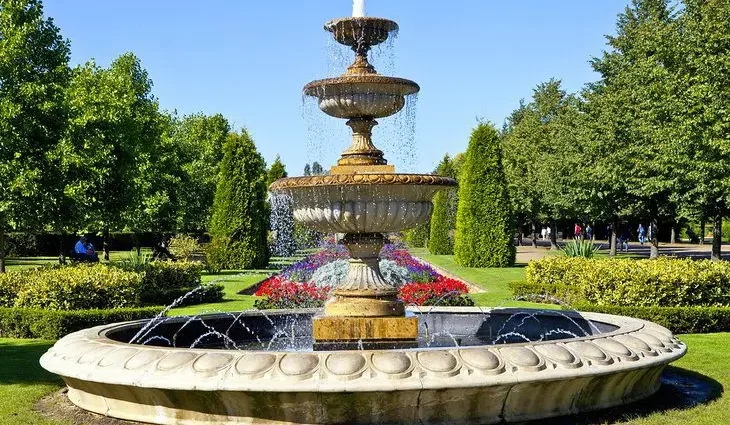Contents
London has no shortage of parks, with approximately 3,000 green spaces within the boroughs. Several, like Greenwich Park, are home to historic buildings and old traditions, while others, like the Queen Elizabeth Olympic Park, have state-of-the-art facilities.
Visitors looking for stunning formal English gardens have plenty of options to choose from, like Battersea Park, and those who are looking for a slice of countryside in the midst of a city will love Hampstead Heath.
Tourists visiting central London’s biggest attractions in and around Soho and Westminster will find a myriad of options nearby within The Regent’s Park and Hyde Park.
Picking which of London’s parks to visit can be a difficult task – make your search for the perfect park easier with our list of the best parks in London.
1. The Regent’s Park
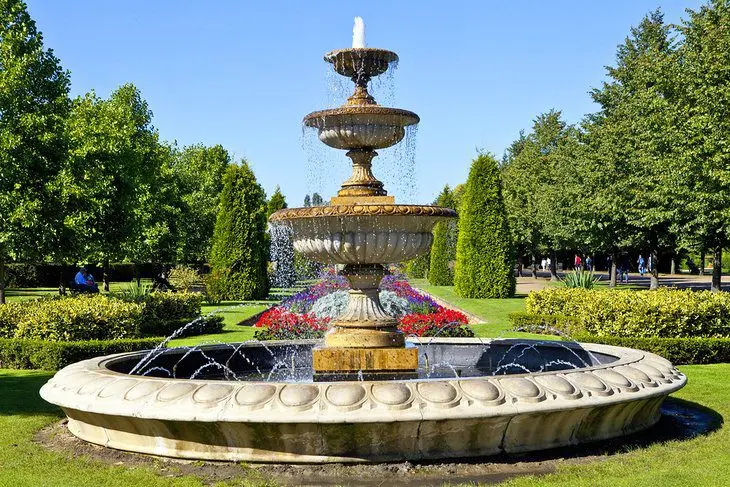
The Regent’s Park may not be London’s largest park, but it is certainly the most diverse of the city’s green spaces, offering formal gardens, wildlife, ponds, sports and entertainment facilities, and of course multiple playgrounds.
Located just north of the Marylebone neighborhood, it sits just beyond the famous Baker Street and is accessible via numerous underground stops. The Inner Circle sits in the southern half of the park, while The Hub recreation area and the zoo occupy the northern section.
A lovely way to enter to park is via The Broad Walk, which starts on the southeastern edge of the park along the Outer Circle. The wide path is flanked by Avenue Gardens, a stunning and meticulously curated formal garden that features seasonal ornamental flowers and greenery and numerous fountains. Its centerpiece is the Griffin Taza, also known as the Lion Vase, a stone bowl held by winged lions.
Visitors will find Queen Mary’s Gardens on the eastern side of the Inner Circle, best known for the nearly 12,000 roses that bloom each June. South from here is the Japanese Garden Island, and to the north sit the Triton and Dryads Fountain and the Regent’s Park Open Air Theater, Britain’s oldest permanent outdoor professional theater. Outside the circle to the west sits the Boating Lake, where tourists can rent rowboats or pedal boats and enjoy watching the resident ducks splash and play; there is also a dedicated children’s boating pond.

Located in the northeastern corner of the park, the ZSL London Zoo is the oldest zoological research facility in the world, first established in 1828. Today, it houses over 750 species, with favorites like giraffes, zebras, lemurs, lions, penguins, gorillas, and many more from around the world. The zoo also offers special up-close experiences and feeding events, as well as on-site lodging for an immersive experience. Animal lovers who aren’t up for a day at the zoo should keep an eye out throughout the park for resident hedgehogs.
No park would be complete without playgrounds, and Regents Park is home to three well-equipped kids’ play areas that each offer both customary play equipment and special activities. Gloucester Gate Playground, located near the zoo, is the most adventurous, with a 50-meter zipline and a climbing wall, as well as water play areas and wheelchair-accessible stations.
On the southern end of the park, Marylebone Green Playground offers three themed “zones,” including an Art Zone with a rock wall; the Natural Zone, with nature-based play; and the Traditional Zone, where there are climbing structures, swings, and other equipment. The Hanover Gate Playground, located next to the children’s pond, features a treehouse.
Primrose Hill, technically its own park, is an extension of The Regent’s Park, sitting on the other side of Prince Albert Road from the zoo. It makes an excellent vantage point for admiring the city below, and the trees around the 63-meter summit are kept trimmed low to allow for maximum views. The summit is also home to Shakespeare’s Tree and a stone inscribed with a William Blake quote about the spot. Primrose Hill also has a playground for children, featuring a climbing structure and music play, which is located at the base of the hill.
Official site: royalparks.org.uk/parks/the-regents-park
2. Crystal Palace Park
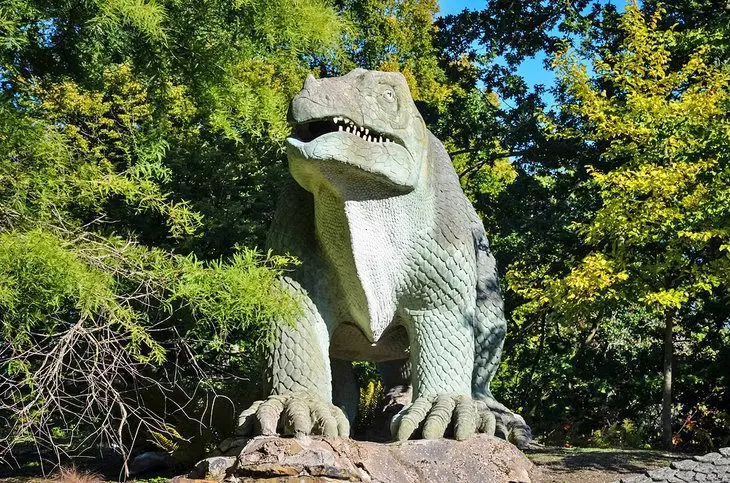
Located southeast of the city center, Crystal Palace Park was named for the impressive iron and glass structure that was built just three years earlier in Hyde Park and then moved to the top of Sydenham Hill in 1854 for the new park’s opening.
Although the original structure burned in 1936, the Crystal Palace Museum was built by the same company as the palace, and today it contains photos, scaled replicas, and artifacts from the grand edifice that visitors can enjoy while at the park. The original Italian Terraces and Sphinx-guarded staircases that once surrounded the palace still stand, giving visitors perspective on the actual size and presence of the former building.
Almost as famous as the palace, this park is also home to the world’s first dinosaur sculptures. Made in 1854, they are technically inaccurate by today’s standards but are nonetheless an impressive collection of towering creatures that still delight kids and adults.
Another old-fashioned but fun activity is the park’s hedge maze, one of the largest in the country. Families will also enjoy the Weekend Farm, an animal habitat that houses rabbits, meerkats, alpacas, and more, with plenty of opportunities to learn.
More active visitors will enjoy the facilities at the National Sports Center (NSC), a huge complex that includes a gym, indoor running track, three pools, and a stadium – all open to the public. The park is also home to an 1,100 square-meter skate park equipped with a variety of terrain for not only skateboarding but also rollerblading, BMX, and other wheeled sports.
For a peaceful end to an active day, visitors can rent a paddleboat to cruise around the park’s lake.
Official site: crystalpalacepark.org.uk
3. Hampstead Heath

Hampstead Heath is a favorite for Londoners, a quiet oasis that provides the illusion of a countryside getaway within one of the world’s busiest cities. This sprawling and irregularly shaped park is located north of the city center, just beyond The Regent’s Park.
Its best-known features are the three natural bathing ponds: one designated for males, another for females, and the third for anyone. There is also a 60-meter lido (outdoor swimming pool), and bathing facilities are open year-round.
In addition to swimming, visitors who have obtained a license can fish in any of five ponds, with pike, perch, and bream among the most common catches. There is also plenty of wildlife, especially birds, that have made the ponds and surrounding habitats home.
Three walking trails lace through the park, ranging from 2.5 kilometers to 9.7 kilometers in length. Those looking for a romantic spot to watch the sun set can easily find a soft patch of grass on Parliament Hill, a hillside also popular in winter for its tobogganing and sledding.
4. Battersea Park
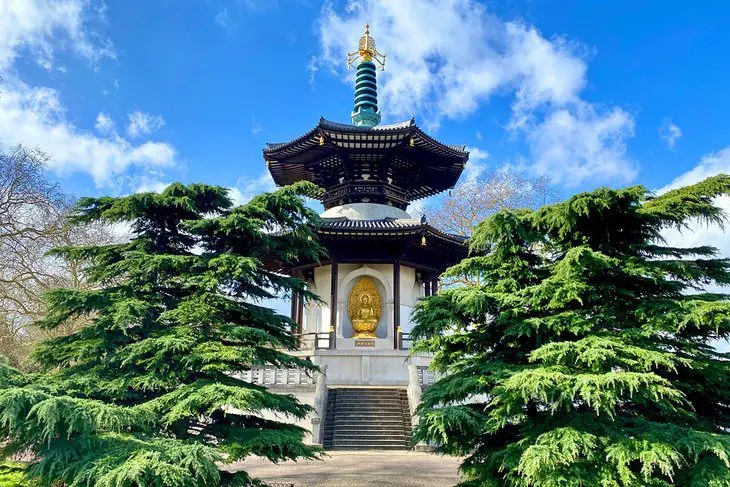
The 200-acre Battersea Park sits adjacent to the southern shore of the Thames, just across the water from the Chelsea borough. Designed in the mid-19th century, the park has many classic Victorian features, as well as some unexpected ones. There are several gardens within the park, including a traditional English Garden; a subtropical garden; and a Winter Garden, which blooms while the rest of the plants slumber.
Families will find plenty of things to do with kids, including several playgrounds and a small zoo that is home to farm animals, adorable capuchin and squirrel monkeys, wallabies, meerkats, lemurs, poison dart frogs, and many more fascinating critters.
There is a lovely promenade along the river, and also a boating lake with a café and plenty of grassy spots for waterside picnics. Be sure not to miss the London Peace Pagoda, built by a Japanese Buddhist after the Second World War.
5. Greenwich Park
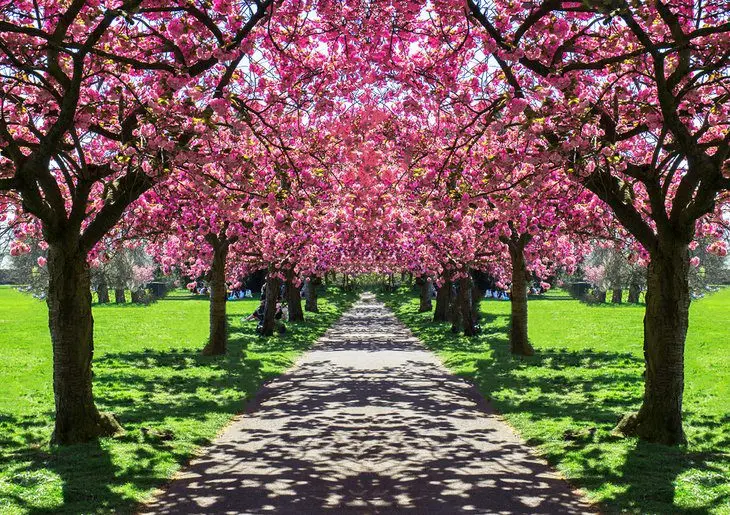
Greenwich Park is best known as the home of the Royal Observatory, which sits atop the park’s hill and marks Greenwich Mean Time and the Prime Meridian. The northern face of the hill is an excellent place to visit for views of London, and at the base of the hill is a maritime-themed playground and the National Maritime Museum.
The park is also home to a great deal of wildlife, including herds of fallow deer and red deer that live in the Wilderness Deer Park. Visitors can learn more about the local flora and fauna at the Secret Garden Wildlife Centre, which has one-way windows for watching the deer without disturbing them. There are also tended gardens, including an orchard and a large rose garden that blooms in June and July.
6. Hyde Park
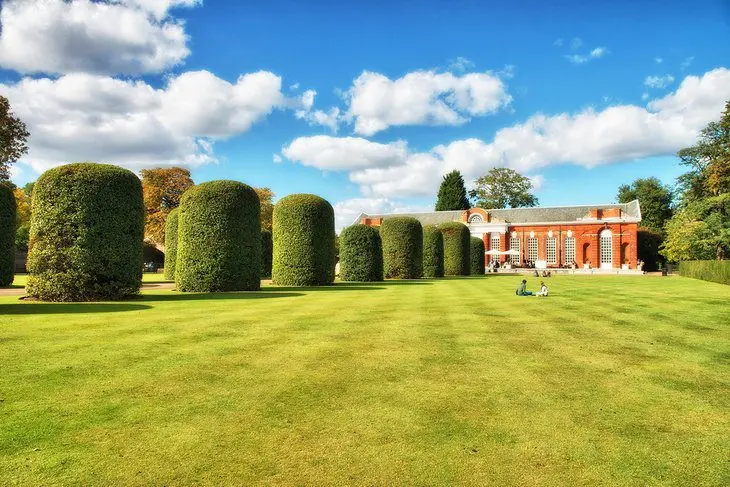
Hyde Park sits between Buckingham Palace and Kensington Palace, adjacent to Kensington Gardens. Hyde Park’s most prominent feature is The Serpentine, a 40-acre lake best known for its swimming club, which races here each year on Christmas Day.
The park covers a total of 350 acres with numerous walking and cycling trails lined by trees, gardens, and plenty of benches. The park is also home to many lovely Victorian buildings, memorials, and fountains, as well as a bandstand and a large playground.
Tourists can find many guided tours of the park, which focus on various aspects, from Victorian London to botany. Highlights include a large rose garden in the southeast corner of the park, which features a range of aromatics, and a wildlife meadow, home to a huge variety of wildlife, especially song birds.
Visitors will also want to take some time to visit the Diana, Princess of Wales Memorial Fountain, located in the eastern side of the park near Serpentine Bridge.
Activities within Hyde Park include swimming, tennis, and horseback riding, and the park hosts numerous events throughout the year including concerts, festivals, and fairs.
7. Holland Park

Holland Park sits on 54 acres just west of Kensington Gardens, named for a 17th-century Jacobean mansion that once sat deep within the woods. Although most of the structure was destroyed during World War II, sections have been preserved, including a terrace that is now used for open-air concerts and theatrical productions.
One of Holland park’s most visited areas is the Kyoto Garden, a stunning area adorned by cherry and Japanese maple trees, a waterfall, peacocks, and, of course, a koi pond with a footbridge arched over the water. There is also an Ecology Centre at the park, which offers educational activities for all ages, as well as an excellent playground with a zipline.
8. Victoria Park
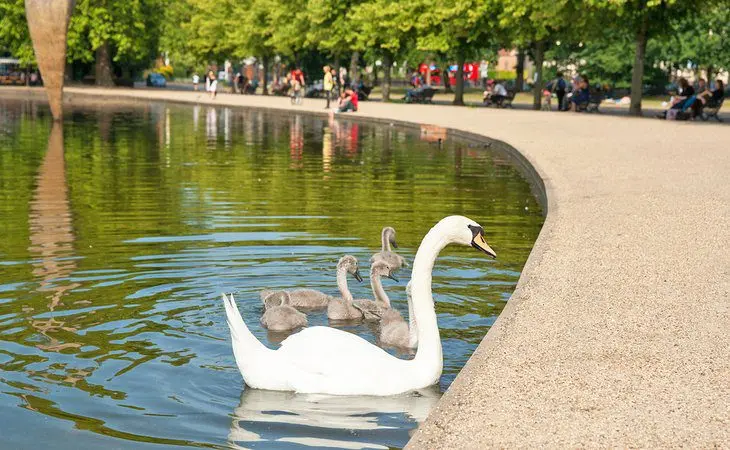
Covering over 210 acres, Victoria Park sits in east London along the Hertford Union Canal, just a few blocks west of Queen Elizabeth Olympic Park. On the eastern side of the park, tourists will find the majority of sports facilities, including a cricket pitch, soccer field, tennis courts, and a running track.
There are also plenty of facilities for family recreation, including the main playground, a splash pad, an impressive skate park, and a model boating lake; the traditional Old English Garden is located just north of the lake and playground.
There is a lake located on the western end of the park as well, and (full-size) boats are available to rent. In the center of the lake sits three small islands, one of which is accessible by a footbridge from both sides. The path loops around the island, leading to the Victoria Park Chinese Pagoda.
The west side of the park also offers several food options, as well as an open-air market on Sundays. Various concerts and events are held at the park throughout warm weather.
9. Queen Elizabeth Olympic Park
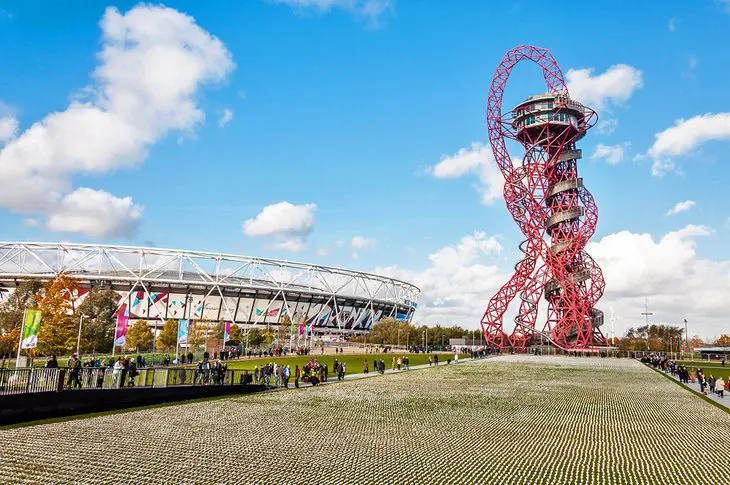
Constructed in East London for the 2012 Olympic Games, Queen Elizabeth Olympic Park is still an impressive sight to behold. Its most iconic landmark is the ArcelorMittal Orbit, a combination of artwork, sightseeing tower, and thrill ride, standing at 114.5 meters tall. From here, visitors can get 360-degree views of London.
More adventurous tourists can take a ride down the 178-meter-long slide, reaching up to 15 miles per hour as the slide twists and turns through the sculpture. This is the UK’s tallest sculpture, and the world’s longest tunnel slide.
As expected, the park is home to numerous sports facilities, including London Stadium, which is the home for the West Ham United football club. The River Lea extends through the park north to south, meeting City Mill River to surround the stadium.
The Waterworks River also splits off from the Lea, and on the banks are where you will find the graceful London Aquatics Center. Other major sports facilities include the Copper Box Arena, the Lee Valley Hockey & Tennis Centre, and a BMX track.
There are plenty of things to do at the park beyond sports, with miles of walking trails, cycling paths, and waterways to explore. There are playgrounds throughout the park, as well as interactive public art installations and formal gardens, like the London Blossom Garden. There is also a lovely nature area called the Wetlands Walk, which provides habitats for many birds.










